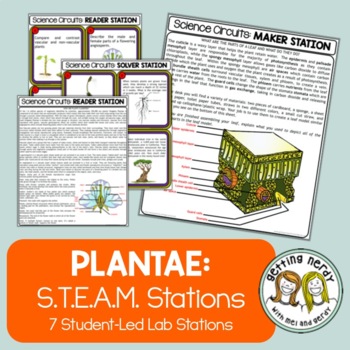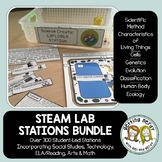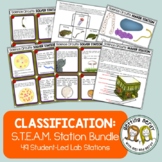Plant Classification - Science Centers / Lab Stations
- Zip
What educators are saying
Also included in
- Want to head full steam into S.T.E.A.M., but not sure how to get started? Try our twist on S.T.E.A.M.! With science as the primary background subject, students learn all about life science using Social Studies, Technology, ELA, Art, and Math. With over 280 stations, these student-led, print and go,Price $209.95Original Price $231.00Save $21.05
- With science as the primary background subject, students will learn about the classification of living things and viruses by using Social Studies, Technology, ELA, Art, and Math. These student-led, print and go, low-to-no prep Science Circuit Stations are easy to implement with a few household itemsPrice $34.95Original Price $38.50Save $3.55
Description
Classification - Science Centers / Lab Stations - Plants Plantae Differentiated Student Led Cross-curricular STEAM Lab Stations
Students will use this plant lab station set to learn about the types of plants, how they obtain food, move, reproduce, and interact within their environment.
With science as the primary background subject, students will learn about the genetics and its components by using Social Studies (which includes history, current events and geography), Technology (computers and engineering), ELA (reading and writing), the Arts (music, art, PE/dance and debate), and Math. These print and go, low-to-no prep Science Circuit Stations are easy to implement with a few household items and provide a method for reinforcing life science that shows how science concepts flow across the curricula and are relatable in all aspects of life.
This Cross-Curricular Science Circuit Station pack includes 7 activities and one assessment aligned to NGSS (Next Generation Science Standards) covering:
- Kingdom Plantae - Plant characteristics and classification including how they move, obtain food and reproduce.
- Angiosperms and Gymnosperms
- Flower composition - male and female flowering plant parts
- Vascular and Non-vascular plants
- Leaf composition
- Photosynthesis
- Tropisms - gravitropism, phototropism, heliotropism, hydrotropism
This product is found in our Life Science Bundle: Cross Curricular STEAM Stations which will include over 40 stations for all Life Science topics!
Our STEAM stations are student-led activities that are great for enrichment, differentiation, assessment, group activities, mini-labs, and more! Students should go into the lessons with some background knowledge on each topic. These unit includes directions for each activity, answer keys, station signs, student answer sheets (which can be turned into an interactive notebook booklet), cover sheet, and blank answer sheets for your own stations.
This Cross-Curricular Science Circuit Station includes the following student-led stations:
Explorer: As an explorer, students engage in Social Studies, Geography, and History as they learn about current events, historical figures and events, etc.
Researcher: Students use a computer, smart phone, ipad or other electronic device to research related topics.
Maker: This station entails students taking on the role of engineering, designing, building, assembling, and/or experimenting with manipulatives.
Scriber: At this station, students write a response to a question or problem.
Reader: Students answer questions related to a reading passage .
Performer: For this station, students get their creative juices flow as they participate in one of the many arts
Solver: Students use their math skills to answer science related math problems
Scholar: An assessment piece that aligns with the lessons included in the Science Circuit
Click this link to find out how this lesson fits with your NGSS, TEKS or GSE Science Classroom
Getting Nerdy's Terms of Use (TOU):
- Purchase of the product is for single classroom use by the purchaser only. It is a violation for individuals, schools, and districts to redistribute, edit, sell, or post this item on the Internet or to other individuals. Disregarding the copyright is a violation of the Digital Millennium Copyright Act and subject to legal action. Clipart and other elements within our products are copyrighted and cannot be used on its own without permission or license.
-By purchasing this product you acknowledge that you have read and understood the Terms of Use.
Cross-Curricular STEAM Circuits Science Stations by © 2016 Getting Nerdy. All rights reserved.







